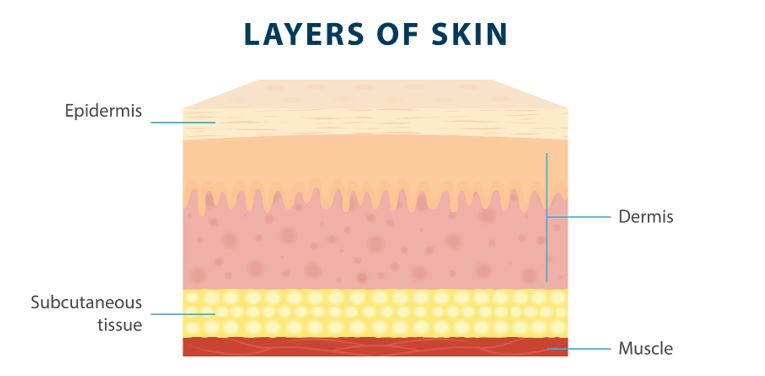Subcutaneous Edema: Symptoms, Causes and Treatment


What Is Subcutaneous Edema?
Subcutaneous edema is swelling (edema) that happens in a specific layer of the skin. Subcutaneous edema is often connected to some form of tissue damage, which can result from another medical condition or an acute injury. Treatment is focused on mitigating the symptoms and swelling that result from this buildup of fluid. If you want to learn more about subcutaneous edema, what causes it, and how it’s treated, keep reading.
What Are the Three Layers of Skin?
What Is Edema?
What Is Subcutaneous Edema?
What Are the Symptoms of Subcutaneous Edema?
What Causes Subcutaneous Edema?
How Do You Treat Subcutaneous Edema?
Wrapping Up: Subcutaneous Edema
What Are the Three Layers of Skin?
Your skin is made up of three layers: the epidermis, the dermis, and the subcutaneous tissue.

The epidermis is the outermost layer of skin, which is what most people think of when they think of skin. The epidermis is responsible for keeping germs and bacteria from getting into your body and causing infections. This layer of skin also gives your skin its color, makes new skin, and supports your immune system through Langerhans cells.1
The dermis is the middle layer of the skin, which is responsible for many of the functions of your skin. The dermis makes oil, grows hair, produces sweat, supplies blood to the epidermis, and more.1
The deepest layer of skin is known as the hypodermis, or the subcutaneous tissue. This is the layer of tissue that comes just before the muscle tissue, and it helps regulate your body temperature and protect your muscles and bones.1 Edema of subcutaneous tissue can affect its ability to perform its crucial roles.
What Is Edema?
Edema is a medical condition characterized by a buildup of fluid in the body’s tissues, resulting in swelling. Fluid levels in the body are typically regulated by your kidneys, lymphatic system, and other parts of the body. When the interstitial fluid in the body isn’t properly regulated, it can build up in the extremities and lead to swelling. This swelling may be accompanied by various symptoms, including pain and skin tightness.
While mild subcutaneous edema may not be a serious concern initially, untreated edema may lead to numerous complications. Edema that isn’t properly managed may eventually lead to blisters, ulcers, and infections, so it’s important to visit a doctor or specialist to figure out a subcutaneous edema treatment plan as soon as possible.
What Is Subcutaneous Edema?
Subcutaneous edema is a specific type of edema that affects the hypodermis layer of skin. Because this deeper layer of skin plays so many important roles, subcutaneous edema can have a serious effect on blood vessels and nerves in the deeper layers of the skin.
One thing to keep in mind is that subcutaneous edema may be associated with other medical conditions, so visiting a doctor for diagnosis is crucial. Untreated chronic subcutaneous edema can lead to cellulitis that is often associated with this condition but is avoidable with proper treatment.
What Are the Symptoms of Subcutaneous Edema?
If you want to prevent edema blisters and other potential complications of subcutaneous edema, it’s important to be aware of the symptoms. If you experience any of these common subcutaneous edema symptoms, you should talk to a doctor or specialist about your treatment options:
- Swelling: As fluid starts to build up in the subcutaneous layer of your skin, it can eventually result in general swelling of the area. You might not notice this swelling until it progresses to a point where it begins to affect your life, such as pain, tight-fitting clothes, and similar symptoms below.
- Shiny skin: Swelling can eventually start to stretch out the skin covering the swollen area, which can change the appearance of your skin. If you notice parts of your skin are especially shiny and smooth-looking, that may result from subcutaneous edema. As edema stretches out your skin and gives it that shiny look, it can also put you at a higher risk for cuts and infections.
- Pain: While some people don’t experience a lot of pain and discomfort as a result of subcutaneous edema, it can be a symptom for others.
- Decreased range of motion: Swelling may start to reduce your range of motion, making it difficult to bend your arms and legs the way you normally would.
- Pitting: Pitting is a term used to describe the indentation that’s left when you press a finger down on the swollen area. Pitting edema is graded based on severity, with higher grades of pitting edema indicating a deeper pit that remains for a longer period of time.
What Causes Subcutaneous Edema?
Like any type of edema, subcutaneous edema may be caused by a combination of lifestyle choices, genetics, medical conditions, and environmental factors. Here are some of the potential causes of subcutaneous edema:2

- Medications: Certain medications, including non-steroidal anti-inflammatory drugs (NSAIDs), corticosteroids, and calcium channel blockers, can increase your risk of developing subcutaneous edema, especially with prolonged use.
- Chronic venous insufficiency: Chronic venous insufficiency is a condition caused by poor vein valve function. When your veins can’t pump blood from the lower extremities back up to your heart, it can damage blood vessels and cause blood to pool in the lower extremities.
- Hot weather: Hot weather may increase your risk of developing edema because it can affect your circulation and how your body retains fluid. Blood vessels dilating as a result of the heat can lead to swelling in the lower extremities.
- Gravity: Fluid in your legs has to work hard to flow against gravity and back up to your heart, so gravity can be a factor when it comes to subcutaneous edema.
- Congestive heart failure: Congestive heart failure and other heart conditions can severely affect your circulation, which can cause a buildup of fluid in certain parts of the body.
- Pregnancy: Pregnancy can put stress on the body, which can cause swelling in areas like the feet, legs, and ankles.
- Kidney or liver disease: Kidney and liver disease can cause edema, as both conditions can lead to fluid retention and lymphatic system overload.
- Blood clots: Blood clots, or deep vein thrombosis (DVT), can cause damage to blood vessels that limits their ability to pump blood.
- Lymphedema: Lymphedema is a condition caused by damage to the lymphatic system, which causes a blockage that leads to a buildup of lymph fluid. This is a common result of cancer and cancer surgery, although it may also be hereditary.
How Do You Treat Subcutaneous Edema?
Before treating subcutaneous edema, it’s important to get a proper diagnosis first. Doctors will often perform a physical examination to identify any symptoms, such as pitting. They may also ask for a medical history and family history to determine if those are contributing factors. In some cases, your doctor may use tests, such as ultrasounds or other tests to rule out certain medical conditions and to diagnose subcutaneous edema. From there, they will work with you to create a treatment plan to help reduce swelling and the progression of symptoms. Here are some common treatments for subcutaneous edema:
- Exercise: Exercising helps encourage the flow of fluids throughout the body, plus it can help you lose weight to make your edema more manageable.
- Reduce salt intake: Higher salt levels cause the body to retain more water, so lowering your salt intake can reduce swelling and other symptoms. You can talk to your doctor to get help figuring out a good diet for edema.
- Treat underlying health conditions: Because subcutaneous edema is often caused by an underlying health condition, such as a blood clot, treating that underlying condition can provide relief from swelling and other symptoms.
- Compress garments and devices: Using gentle compression can help guide fluid away from swollen areas to reduce swelling. Compression garments are tight-fitting clothing that are designed to increase fluid flow to reduce swelling.
- Pneumatic compression devices: Pneumatic compression devices like the Flexitouch Plus system from Tactile Medical apply intermittent pressure to improve the flow of fluid and reduce symptoms like swelling.
- Hydration: Dehydration can affect blood and fluid flow throughout the body, so ensure you drink plenty of water to relieve swelling and other edema symptoms.
- Elevation: Because gravity can make it difficult for blood to flow back up to the heart, elevating swollen extremities can reverse the effects of gravity.
- Manual lymphatic drainage: Manual lymphatic drainage using a special massage technique can help reduce swelling caused by lymphedema. You can receive training from a trained lymphedema therapist to learn the proper techniques, then perform these massages at home.
Wrapping Up: Subcutaneous Edema
Getting an early diagnosis for subcutaneous edema is essential to determine a treatment plan. Fortunately, subcutaneous edema can be managed with basic treatment, including compression, exercise, diet, and elevation.
Do you need help getting relief from swelling and other edema symptoms? The Flexitouch Plus system from Tactile Medical can help. If you want to learn more about the Flexitouch Plus and how it can help you reduce swelling, get in touch with Tactile Medical today.
References
1. Yousef H, Alhajj M, Sharma S. Anatomy, Skin (Integument), Epidermis. StatPearls. Treasure Island (FL): StatPearls Publishing; 2022 Jan. https://www.ncbi.nlm.nih.gov/books/NBK470464/
2. Gale Encyclopedia of Medicine. Edema. 2008. https://medical-dictionary.thefreedictionary.com/subcutaneous+edema